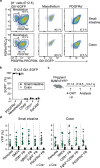The small and large intestine contain related mesenchymal subsets that derive from embryonic Gli1+ precursors
- PMID: 37085516
- PMCID: PMC10121680
- DOI: 10.1038/s41467-023-37952-5
The small and large intestine contain related mesenchymal subsets that derive from embryonic Gli1+ precursors
Abstract
The intestinal lamina propria contains a diverse network of fibroblasts that provide key support functions to cells within their local environment. Despite this, our understanding of the diversity, location and ontogeny of fibroblasts within and along the length of the intestine remains incomplete. Here we show that the small and large intestinal lamina propria contain similar fibroblast subsets that locate in specific anatomical niches. Nevertheless, we find that the transcriptional profile of similar fibroblast subsets differs markedly between the small intestine and colon suggesting region specific functions. We perform in vivo transplantation and lineage-tracing experiments to demonstrate that adult intestinal fibroblast subsets, smooth muscle cells and pericytes derive from Gli1-expressing precursors present in embryonic day 12.5 intestine. Trajectory analysis of single cell RNA-seq datasets of E12.5 and adult mesenchymal cells suggest that adult smooth muscle cells and fibroblasts derive from distinct embryonic intermediates and that adult fibroblast subsets develop in a linear trajectory from CD81+ fibroblasts. Finally, we provide evidence that colonic subepithelial PDGFRαhi fibroblasts comprise several functionally distinct populations that originate from an Fgfr2-expressing fibroblast intermediate. Our results provide insights into intestinal stromal cell diversity, location, function, and ontogeny, with implications for intestinal development and homeostasis.
© 2023. The Author(s).
Conflict of interest statement
SB has ownerships in Intomics A/S, Hoba Therapeutics Aps, Novo Nordisk A/S, Lundbeck A/S, ALK abello A/S and managing board memberships in Proscion A/S and Intomics A/S. The remaining authors declare no competing interests.
Figures






Similar articles
-
GLI1-expressing mesenchymal cells form the essential Wnt-secreting niche for colon stem cells.Nature. 2018 Jun;558(7710):449-453. doi: 10.1038/s41586-018-0190-3. Epub 2018 Jun 6. Nature. 2018. PMID: 29875413
-
Intestinal myofibroblasts: targets for stem cell therapy.Am J Physiol Gastrointest Liver Physiol. 2011 May;300(5):G684-96. doi: 10.1152/ajpgi.00474.2010. Epub 2011 Jan 20. Am J Physiol Gastrointest Liver Physiol. 2011. PMID: 21252048 Free PMC article. Review.
-
Col6a1+/CD201+ mesenchymal cells regulate intestinal morphogenesis and homeostasis.Cell Mol Life Sci. 2021 Dec 15;79(1):1. doi: 10.1007/s00018-021-04071-7. Cell Mol Life Sci. 2021. PMID: 34910257 Free PMC article.
-
Lamina propria T cell subsets in the small and large intestine of euthymic and athymic mice.Scand J Immunol. 1995 Aug;42(2):191-201. doi: 10.1111/j.1365-3083.1995.tb03645.x. Scand J Immunol. 1995. PMID: 7631153
-
Mesenchymal Cells in Colon Cancer.Gastroenterology. 2017 Apr;152(5):964-979. doi: 10.1053/j.gastro.2016.11.049. Epub 2017 Jan 20. Gastroenterology. 2017. PMID: 28111227 Review.
Cited by
-
Telocytes in inflammatory bowel diseases: contributions to pathology and therapeutic potentials.Front Cell Dev Biol. 2025 Jan 13;12:1452258. doi: 10.3389/fcell.2024.1452258. eCollection 2024. Front Cell Dev Biol. 2025. PMID: 39872845 Free PMC article. Review.
-
Effects of embryonic origin, tissue cues and pathological signals on fibroblast diversity in humans.Nat Cell Biol. 2025 May;27(5):720-735. doi: 10.1038/s41556-025-01638-5. Epub 2025 Apr 22. Nat Cell Biol. 2025. PMID: 40263573 Review.
-
Chronic arsenic exposure affects stromal cells and signaling in the small intestine in a sex-specific manner.Toxicol Sci. 2024 Mar 26;198(2):303-315. doi: 10.1093/toxsci/kfae016. Toxicol Sci. 2024. PMID: 38310360 Free PMC article.
-
An image-based transcriptomics atlas reveals the regional and microbiota-dependent molecular, cellular, and spatial structure of the murine gut.bioRxiv [Preprint]. 2025 Jul 24:2025.07.21.665958. doi: 10.1101/2025.07.21.665958. bioRxiv. 2025. PMID: 40777313 Free PMC article. Preprint.
-
Mapping mesenchymal diversity in the developing human intestine and organoids.bioRxiv [Preprint]. 2025 Jul 22:2025.07.22.665939. doi: 10.1101/2025.07.22.665939. bioRxiv. 2025. PMID: 40777494 Free PMC article. Preprint.
References
-
- Parikh, K. et al. Colonic epithelial cell diversity in health and inflammatory bowel disease. Nature1, 10.1038/s41586-019-0992-y (2019). - PubMed
Publication types
MeSH terms
Substances
LinkOut - more resources
Full Text Sources
Molecular Biology Databases
Miscellaneous

